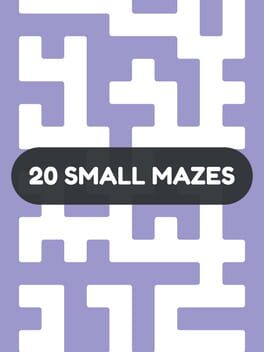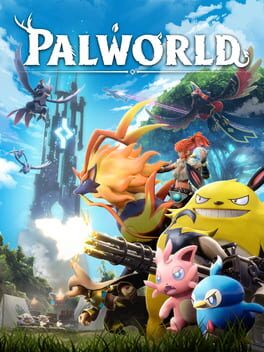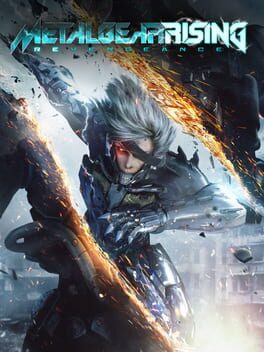saccharin
37 reviews liked by saccharin
20 Small Mazes
2024
"Why Henry? *sniffle* Why are you rating this? Its a bunch of mazes you beat in a single 35 minute sitting! You might as well rate the Saturday morning sudoko in the local newspaper as well! Waaah waaah."
Shut up twerp. My grandfather served in the second world war. Every day my grandmother didn't know if he'd come home. But once a month she'd receive a letter from the front lines confirming his survival. "Sarge gave me the Newspaper for this week, cross word was a bit shit this time, 3/5." I am honouring a multi generational legacy with this rating. I am literally fighting a war on backloggd.com right now. What are you doing? Playing Final Fantasy 7-2.67? How about you get a grip before you tell me how to run MY account.
Shut up twerp. My grandfather served in the second world war. Every day my grandmother didn't know if he'd come home. But once a month she'd receive a letter from the front lines confirming his survival. "Sarge gave me the Newspaper for this week, cross word was a bit shit this time, 3/5." I am honouring a multi generational legacy with this rating. I am literally fighting a war on backloggd.com right now. What are you doing? Playing Final Fantasy 7-2.67? How about you get a grip before you tell me how to run MY account.
Palworld
2024
Palworld
2024
Balatro
2024
Vampire Survivors
2021
not morally egregious per se but rather a depressing culmination of a decade's worth of design trickery and (d)evolving cultural/social tastes and otherwise exists as insipid twitchcore autoplaying bullshit that should come with a contractual agreement binding its devotees to never speak prejudicially about mobile games or musou ever again lest they face legally enforced financial restitution. just play nex machina man. or watch NFL. been a fun season for that. fuck the review man let's talk sports in the comments
Prey
2017
A spectacular smorgasbord of setting that fuses more or less everything that's great about the science-fiction genre into a single cohesive and highly-interactive experience, taking pages from Alien, The Thing, The Matrix and everything in between, elevating them gracefully with pop-phil touches of Thomas Kuhn and dynamic lighting effects. I'd go so far as to suggest Prey is one of gaming's most well-realised worlds ever, with Arkane leveraging their Zenimax-Bethesda business relationship in creative-personal-inspirational ways that aren’t just related to the budget and resources their parent company provided - some of the email terminals contain such ruthlessly well-observed treatise on corporate engineering that I have a sneaking suspicion someone may have just find-replaced some exchanges from Arkane's own SMTP server. Seem like the level designers had a real knack for finding horror in conference rooms, employee lounges and HR tribunals.
Engagement with the environment is Prey’s greatest strength. By forcing you to crawl around on your hands like a fucking dog and stick your head into trashcans in the hopes of scrounging up some used cigars and banana peels, the game encourages you to take a close look at everything around you. Every discarded dossier and email chain is a potential piece of practical benefit, which often results in you combing archived arguments between the deceased cafeteria staff RE: Tuesday’s lunch special for mentions of a door code or safe combination - classic imsim fare, but wrapped in mundane-yet-engaging writing that definitively proves that audio logs, post-it notes and graffiti are effective storytelling techniques - it’s just that most games have used them to tell terrible stories.
The killer flaw here is the combat, which serves more as an unpleasant obstacle between you and more digestion of setting than a creative exercise that’s in keeping with the game’s otherwise giddy open-endedness. Fighting the typhon is clumsy, brutal and stupid - and while it’s perhaps an intentional realisation of the game's classic "you saved the galaxy with repair tools?!" design ideology, it harkens too closely to the stiff awkwardness of taking on headcrabs with a crowbar in Half-Life or those moments in Deux Ex where you and a FEMA agent trade stun-gun blows for five minutes until one of your inventories runs out of potato chips. It’s regressive RPG-shooter gameplay (complete with number pop-ups) that ultimately can’t find its place within an otherwise highly-finessed immersion tank. The game offers you ample chance to blow fiery holes in gas pipes and transform into toilet roll for a surprise attack on unwitting plumbing droids, but these moments of brilliance invariably descend into rigid battle-exchanges between you and the AI; blind stat-crunching that never makes you feel as clever as the environmental puzzle-solving does. Excise the guns completely (apart from the wonderful glue cannon, of course) and I honestly think you might have a better game - the only bullets I took satisfaction in firing were the foam-tipped crossbow bolts that I could use to sneakily activate touchscreens from across a room.
At its best, Prey is a game of corporate archaeology - investigate the sterile halls of an isolated institution and work out why only ghosts roam its corridors now. You can only hide in the shadows for so long , though, before you’re faced with the ugly consequences of industrial actions - both yours and theirs. But don’t worry! Even this nuanced near-missterpiece offers you the opportunity to stand in front of a machine and choose between switches marked “KILL” and “SAVE”. Would you kindly check it out, please? Because I need a Prey 2 to come in and patch up the broken joints in this brilliant mechanical simulation.
Engagement with the environment is Prey’s greatest strength. By forcing you to crawl around on your hands like a fucking dog and stick your head into trashcans in the hopes of scrounging up some used cigars and banana peels, the game encourages you to take a close look at everything around you. Every discarded dossier and email chain is a potential piece of practical benefit, which often results in you combing archived arguments between the deceased cafeteria staff RE: Tuesday’s lunch special for mentions of a door code or safe combination - classic imsim fare, but wrapped in mundane-yet-engaging writing that definitively proves that audio logs, post-it notes and graffiti are effective storytelling techniques - it’s just that most games have used them to tell terrible stories.
The killer flaw here is the combat, which serves more as an unpleasant obstacle between you and more digestion of setting than a creative exercise that’s in keeping with the game’s otherwise giddy open-endedness. Fighting the typhon is clumsy, brutal and stupid - and while it’s perhaps an intentional realisation of the game's classic "you saved the galaxy with repair tools?!" design ideology, it harkens too closely to the stiff awkwardness of taking on headcrabs with a crowbar in Half-Life or those moments in Deux Ex where you and a FEMA agent trade stun-gun blows for five minutes until one of your inventories runs out of potato chips. It’s regressive RPG-shooter gameplay (complete with number pop-ups) that ultimately can’t find its place within an otherwise highly-finessed immersion tank. The game offers you ample chance to blow fiery holes in gas pipes and transform into toilet roll for a surprise attack on unwitting plumbing droids, but these moments of brilliance invariably descend into rigid battle-exchanges between you and the AI; blind stat-crunching that never makes you feel as clever as the environmental puzzle-solving does. Excise the guns completely (apart from the wonderful glue cannon, of course) and I honestly think you might have a better game - the only bullets I took satisfaction in firing were the foam-tipped crossbow bolts that I could use to sneakily activate touchscreens from across a room.
At its best, Prey is a game of corporate archaeology - investigate the sterile halls of an isolated institution and work out why only ghosts roam its corridors now. You can only hide in the shadows for so long , though, before you’re faced with the ugly consequences of industrial actions - both yours and theirs. But don’t worry! Even this nuanced near-missterpiece offers you the opportunity to stand in front of a machine and choose between switches marked “KILL” and “SAVE”. Would you kindly check it out, please? Because I need a Prey 2 to come in and patch up the broken joints in this brilliant mechanical simulation.
Half-Life 2
2004
Seven years after my initial playthrough and a few years since my previous replay, which was formerly a twice annual occurrence for me, Half-Life 2 remains one of the best sequels and one of the absolute coolest games I've ever experienced. I suppose I got a bit burnt out after a number of replays in the span just a few years, but despite having this game committed mostly to memory, I was so captivated this time around that it felt as though I was experiencing it for the first time again.
Although the manner in which the original Half-Life was built around the uninterrupted perspective of an ordinary scientist navigating a single disaster-stricken facility stands out when compared to the structure of its sequel, Half-Life 2 is simply more refined in every way. Games that make a point of flaunting their technical prowess tend not to age gracefully, but this game's decision to wear the newfound power of the Source Engine on its sleeve is an essential part of its identity that sets it apart from its predecessor's brand of naturalism. The art direction has held up wonderfully - although the outskirts of the nonspecific eastern European setting are a bit barren, the scale of the environments draws attention away from the lacking texture detail, and the contrast of the Combine architecture and technology effectively communicates the extent to which they've conquered the Earth and the desolation of the citizens who live under their rule. Perhaps the most defining feature of Half-Life 2 is its emphasis on physics, the design decision that posed by far the biggest risk to the game's longevity. Puzzles such as one that showcases the physics engine's capability to emulate a makeshift seesaw are more of a flex than they are clever game design, but I find them charming in a way that most boundary-pushing games from this point onwards aren't, and the abundance of interactive props and objects is something that I've seldom seen in other titles, giving it a distinctly immersive touch. The Gravity Gun epitomizes this physics-based gameplay, allowing you to literally weaponize your surroundings in a manner that remains somewhat novel to this day. The other combat maneuvers it enables, such as picking up a Combine-thrown grenade and hurling it back at them, never lose their luster.
In addition to its cutting-edge visuals standing the test of time, Half-Life 2 arguably excels even further in the sound department. The voice performances remain some of the best in the medium to date, doing wonders to endear me to cast of characters that wouldn't be particularly memorable otherwise. Robert Culp does an especially great job as Breen, a spineless puppet of an antagonist who leaves far more of an impression than a dictator one might expect from the setting would have. Kelly Bailey's sparingly-used soundtrack consisting of unsettling ambience to establish the atmosphere and pulse-pounding techno to complement the most thrilling fights is even stronger than before - nearly every appearance of music throughout the game is a highlight. The sound design might just be my favorite of any video game - from the anguished cries of the zombies to the ear-piercing whirs and scratching of the Manhacks to the flattening lifelines of the Metrocops, the soundscape is ingrained into my memory and breathes so much more life into an already distinct aesthetic.
The first two thirds of Half-Life 2 are a near-perfect experience, featuring striking environmental storytelling, an engrossing atmosphere, and consistently creative encounter design delivered at a pace that had me completely enamored. Insertion Point is nearly unmatched in its effectiveness at introducing its setting; We Don't Go to Ravenholm is an unforgettable shift to survival horror that maintains everything that makes the game work in a vastly different setting; Highway 17 takes the formula of the previous game's infamous On a Rail and executes it with finesse; every chapter has something exciting to bring to the table. Not even the occasional mechanical shortcomings such as the perplexing inaccuracy of the pistol could hinder my enjoyment, and the occasional frustration I've been met with in previous runs in chapters such as Water Hazard was nowhere to be found this time around. Unfortunately, like its predecessor, Half-Life 2 abandons some it strongest design principles in the final act, although in more subtle ways than before. The sudden shift to radically different circumstances starts off a lot more exciting - Anticitizen One is a tightly design series of setpieces that, while rendering the Gravity Gun more situational than it had been, is still really damn fun. Follow Freeman, however, is too long for its own good and is more rigid with its encounter design. Nothing but its high stakes can justify the presence of half-baked squad mechanics, lots of narrow hallways, an all but explicit insistence on making heavy use of the shotgun and pulse rifle (which are perhaps too universally useful compared to the rest of Gordon's arsenal), and a volume of obnoxiously resilient Striders that makes save scumming downright necessary on the highest difficulty. I'm making all of this sound worse than it is in execution, but it's nonetheless a noticeable step down from the amazing chapters that precede it. Our Benefactors and Dark Energy serve as a gimmicky finale, but the gimmick in question is an absolute blast, and the one sequence of the game in which you're robbed of full control is one of its most memorable.
Overall, this replay is probably the most fun I've ever had with Half-Life 2. It's not entirely free of missteps, but I can't overstate just how great it is for the vast majority of its duration. It's an absolute must play for shooter fans, and well deserving of its reputation as one of the all time greats.
Although the manner in which the original Half-Life was built around the uninterrupted perspective of an ordinary scientist navigating a single disaster-stricken facility stands out when compared to the structure of its sequel, Half-Life 2 is simply more refined in every way. Games that make a point of flaunting their technical prowess tend not to age gracefully, but this game's decision to wear the newfound power of the Source Engine on its sleeve is an essential part of its identity that sets it apart from its predecessor's brand of naturalism. The art direction has held up wonderfully - although the outskirts of the nonspecific eastern European setting are a bit barren, the scale of the environments draws attention away from the lacking texture detail, and the contrast of the Combine architecture and technology effectively communicates the extent to which they've conquered the Earth and the desolation of the citizens who live under their rule. Perhaps the most defining feature of Half-Life 2 is its emphasis on physics, the design decision that posed by far the biggest risk to the game's longevity. Puzzles such as one that showcases the physics engine's capability to emulate a makeshift seesaw are more of a flex than they are clever game design, but I find them charming in a way that most boundary-pushing games from this point onwards aren't, and the abundance of interactive props and objects is something that I've seldom seen in other titles, giving it a distinctly immersive touch. The Gravity Gun epitomizes this physics-based gameplay, allowing you to literally weaponize your surroundings in a manner that remains somewhat novel to this day. The other combat maneuvers it enables, such as picking up a Combine-thrown grenade and hurling it back at them, never lose their luster.
In addition to its cutting-edge visuals standing the test of time, Half-Life 2 arguably excels even further in the sound department. The voice performances remain some of the best in the medium to date, doing wonders to endear me to cast of characters that wouldn't be particularly memorable otherwise. Robert Culp does an especially great job as Breen, a spineless puppet of an antagonist who leaves far more of an impression than a dictator one might expect from the setting would have. Kelly Bailey's sparingly-used soundtrack consisting of unsettling ambience to establish the atmosphere and pulse-pounding techno to complement the most thrilling fights is even stronger than before - nearly every appearance of music throughout the game is a highlight. The sound design might just be my favorite of any video game - from the anguished cries of the zombies to the ear-piercing whirs and scratching of the Manhacks to the flattening lifelines of the Metrocops, the soundscape is ingrained into my memory and breathes so much more life into an already distinct aesthetic.
The first two thirds of Half-Life 2 are a near-perfect experience, featuring striking environmental storytelling, an engrossing atmosphere, and consistently creative encounter design delivered at a pace that had me completely enamored. Insertion Point is nearly unmatched in its effectiveness at introducing its setting; We Don't Go to Ravenholm is an unforgettable shift to survival horror that maintains everything that makes the game work in a vastly different setting; Highway 17 takes the formula of the previous game's infamous On a Rail and executes it with finesse; every chapter has something exciting to bring to the table. Not even the occasional mechanical shortcomings such as the perplexing inaccuracy of the pistol could hinder my enjoyment, and the occasional frustration I've been met with in previous runs in chapters such as Water Hazard was nowhere to be found this time around. Unfortunately, like its predecessor, Half-Life 2 abandons some it strongest design principles in the final act, although in more subtle ways than before. The sudden shift to radically different circumstances starts off a lot more exciting - Anticitizen One is a tightly design series of setpieces that, while rendering the Gravity Gun more situational than it had been, is still really damn fun. Follow Freeman, however, is too long for its own good and is more rigid with its encounter design. Nothing but its high stakes can justify the presence of half-baked squad mechanics, lots of narrow hallways, an all but explicit insistence on making heavy use of the shotgun and pulse rifle (which are perhaps too universally useful compared to the rest of Gordon's arsenal), and a volume of obnoxiously resilient Striders that makes save scumming downright necessary on the highest difficulty. I'm making all of this sound worse than it is in execution, but it's nonetheless a noticeable step down from the amazing chapters that precede it. Our Benefactors and Dark Energy serve as a gimmicky finale, but the gimmick in question is an absolute blast, and the one sequence of the game in which you're robbed of full control is one of its most memorable.
Overall, this replay is probably the most fun I've ever had with Half-Life 2. It's not entirely free of missteps, but I can't overstate just how great it is for the vast majority of its duration. It's an absolute must play for shooter fans, and well deserving of its reputation as one of the all time greats.
Doom Eternal
2020
A shame. The sleekness of DOOM (2016) is nowhere to be found—it’s been replaced with ugly garishness in nearly every facet of Eternal’s design.
The chonky combat remains, with gun-feel and glory kill animations improved considerably—and the music is still great!—but that’s where the positives end. The game is pumped absolutely chock-full with annoying, difficult-to-internalize mechanics, overwrought platforming puzzles (the effortless platforming in 2016 is so much better!), and a stupid, hamfisted story and atmosphere.
The appeal of DOOM (2016) had a lot to do with the interplay of self-serious elements and campy ones. It was like watching a B-movie that believed, wholeheartedly, in its own awesomeness. Eternal just plops face-first into campy mud, goofifying everything and winking at the player incessantly, sapping the game of any actual coolness. Those moments of quiet viscerality from the first game are half-assed or just completely non-existent.
Id has cranked the difficulty up, both in terms of enemy aggressiveness and, just, the sheer amount of bullshit you have to learn and remember. Oh I can grapple and blood punch and flame belch and chainsaw and double dash and ice grenade OR regular grenade, in addition to shooting my weapons with hot-swappable mods? Cool! Is it any fun to juggle it all, really? No, it isn’t!
I came back to Eternal thinking I’d been too hard on it, and found just the opposite— I like it even less now. It infuriatingly squanders the potential of its fantastic predecessor, going decidedly for content quantity over quality, and losing almost everything that made the latter feel special. While it’s not terrible in its own right, I consider it one of my personal biggest disappointments of the modern gaming era.
The chonky combat remains, with gun-feel and glory kill animations improved considerably—and the music is still great!—but that’s where the positives end. The game is pumped absolutely chock-full with annoying, difficult-to-internalize mechanics, overwrought platforming puzzles (the effortless platforming in 2016 is so much better!), and a stupid, hamfisted story and atmosphere.
The appeal of DOOM (2016) had a lot to do with the interplay of self-serious elements and campy ones. It was like watching a B-movie that believed, wholeheartedly, in its own awesomeness. Eternal just plops face-first into campy mud, goofifying everything and winking at the player incessantly, sapping the game of any actual coolness. Those moments of quiet viscerality from the first game are half-assed or just completely non-existent.
Id has cranked the difficulty up, both in terms of enemy aggressiveness and, just, the sheer amount of bullshit you have to learn and remember. Oh I can grapple and blood punch and flame belch and chainsaw and double dash and ice grenade OR regular grenade, in addition to shooting my weapons with hot-swappable mods? Cool! Is it any fun to juggle it all, really? No, it isn’t!
I came back to Eternal thinking I’d been too hard on it, and found just the opposite— I like it even less now. It infuriatingly squanders the potential of its fantastic predecessor, going decidedly for content quantity over quality, and losing almost everything that made the latter feel special. While it’s not terrible in its own right, I consider it one of my personal biggest disappointments of the modern gaming era.
In the anime series Yu Yu Hakusho, there is an object called the Chapter Black which showcases all of humanity's misdeeds and is depicted as so horrifying that it causes anyone who watches it to show nothing but utter contempt for humanity.
The real world equivalent is a multiplayer game of New Super Mario Bros. Wii.
The real world equivalent is a multiplayer game of New Super Mario Bros. Wii.








